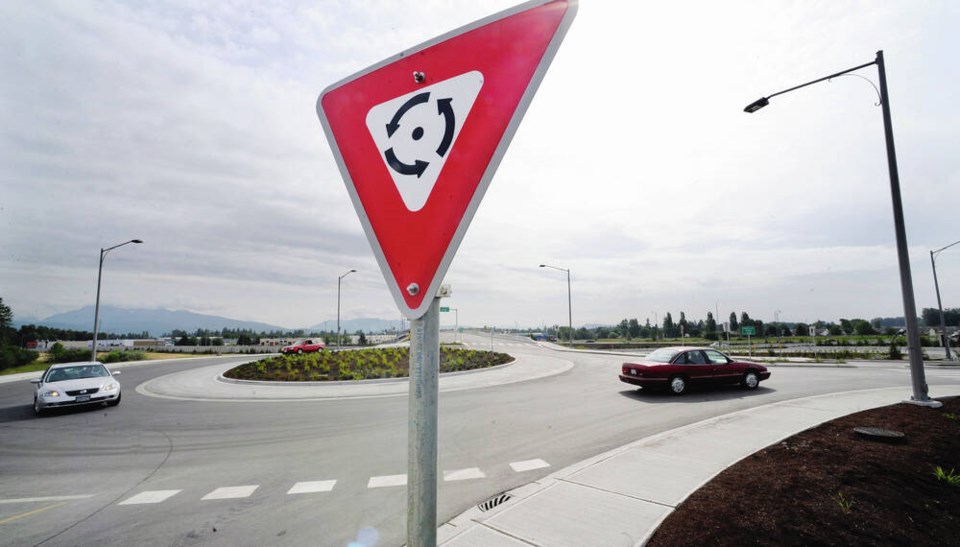Roundabouts are now a common part of driving on Vancouver Island. Generally they offer a good alternative to traditional intersections based on the idea of creating efficient traffic flow which improves road safety. For the most part, they work.
But based on the steady stream of emails I receive it’s clear that they are still presenting difficulties for some drivers.
The most important part of roundabout negotiation is to actually do what the sign says as you approach — Yield To Traffic In The Circle. Unfortunately, I’ve seen this breakdown on several occasions.
Some drivers assume that because they are entering the circle from a busier road that they have a carte blanche right of way. Not true. I was cut-off on Helmcken Road the other night by a woman ignoring this simple but important rule.
Vehicles inside the roundabout have the right of way, and it is your responsibility to yield to them regardless of the higher volume on the street from which you enter the circle. Regardless of direction, all drivers should exercise caution and merge smoothly into the roundabout when it is safe to do so. Preventing a collision is the best outcome — even if the other driver is in the wrong.
A critical roundabout skill is accurately assessing gaps in traffic. Judging the speed and distance of approaching vehicles can be challenging, especially when there are several entry points. So it’s better to be a little slower and observe the flow of traffic to pick out suitable gaps to enter, especially at the bigger roundabouts.
Rushing into a roundabout and making sudden manoeuvres are the worst things to do. With practice, you will develop a better sense of timing and improve your ability to judge gaps effectively.
Roundabouts by design feature multiple exits. This can be challenging especially at peak traffic hours. Pay attention to the direction signs, which for the most part tell you clearly where you need to go.
It’s sometimes difficult because our roundabouts here are smaller than ones overseas, so using indicators to signal your intentions is also important to let others know what you’re doing. Stay focused, especially if the roundabout has more than one lane of travel. Change lanes smoothly while signalling as you approach your exit.
Roundabouts are intersections and therefore will also accommodate cyclists and pedestrians — another layer of complexity for drivers using them. Remember that to exit onto the street you want, you’ll most likely need to pass over a crosswalk and pedestrians always seem to cross when you least expect them.
A multi-lane roundabout has its own set of challenges. Lane selection, while making tight turns, can be perplexing even for experienced drivers. One key is to move into the lane you need sooner rather than later. This lowers the chance of needing to suddenly change lanes — often in front of another car.
Another common complaint is the lack of visibility at some roundabouts. Many have beautification landscaping and/or street ornamentation which can block your view.
The key here is to reduce speed and prepare for the unexpected. Keep awareness on the whole roadway, not just where you need to go. Other cars will come in from your left but always be ready to react if that other driver ignored the golden rule of yielding to traffic already in the circle.
In the end, the major problem seems to be a lack of familiarity with roundabout rules which often leads to hesitation and confusion. If you’re unsure, there are several good sources online which can show you safe and effective ways to negotiate roundabouts.
What about before you enter the circle? We have several smaller roundabouts in this area which means that you can usually see if another car is approaching from a different direction at the same time. Then the old intersection rule applies: yield to the vehicle approaching from the right.
To be clear, this rule applies only “when approaching” the roundabout, not when you or another car have already entered the circle. Again, the vehicle already in the circle has the right of way.
Remember, patience, attentiveness, and adherence to traffic rules are key to safely and efficiently manoeuvring through roundabouts. With a bit of practice and experience, you’ll become a confident roundabout navigator.
Glove Box: Distracted driving isn’t always about using a cellphone. A trucker in Pennsylvania, noshing on an apple, somehow managed to choke himself into unconsciousness behind the wheel. His rig went off the road and crashed through a concrete barrier before coming to a stop. Fortunately no one else was hurt. The downside was a ticket for careless driving but the upside was that the force of the crash dislodged the apple from the trucker’s throat - saving his life.



